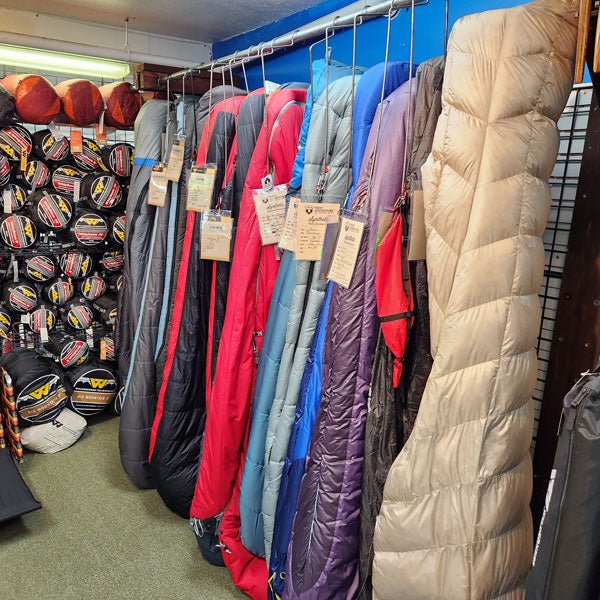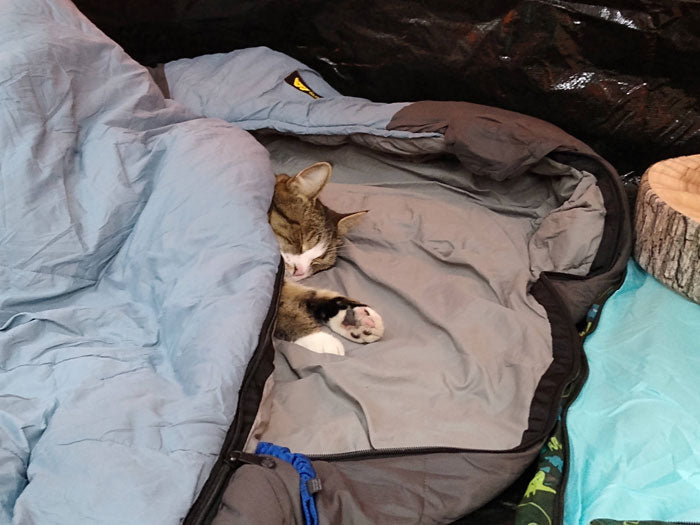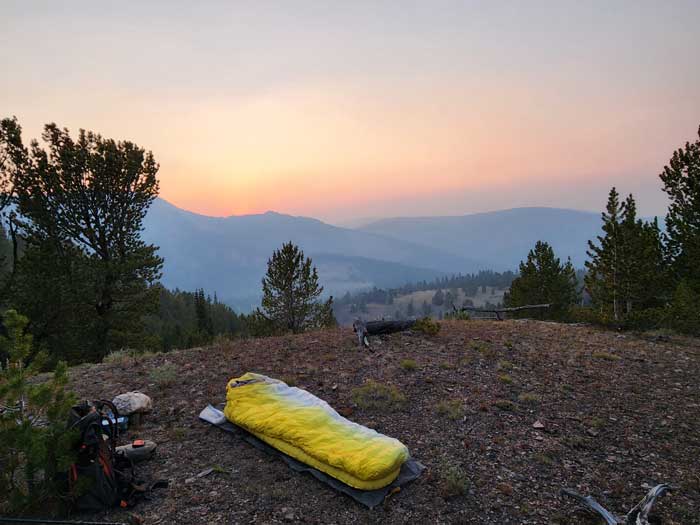
Buying Guide: Sleeping Bags
So, you’re looking to buy a new sleeping bag? Great! A sleeping bag is one of the most important pieces of equipment in a camping setup; whether you’re headed out for a relaxing weekend by the lake or setting off on an overnight backpacking trip, having the right sleeping bag is essential for staying warm and getting a good night’s sleep. But with so many sleeping bags available, choosing the right product can be overwhelming. This blog post will help you sort through the many options available. We’ll discuss temperature rating, fill material, and some of the features of sleeping bags that can be beneficial to specific types of use. I’ll also give some tips for caring for your new sleeping bag and highlight a few of my favorite options available on our website.
First and foremost, it’s important to consider when and where you’re planning to use your sleeping bag. A 2-lb down-filled mummy sleeping bag and a 10-pound flannel-lined rectangular sleeping bag obviously aren’t intended for the same type of use. Before looking at your options, ask yourself the following questions:
- Where do I plan to use this sleeping bag? (Will it be carried on backpacking trips, or only used in the backyard?)
- When do I plan to use this sleeping bag? (Are you a summertime camper, or a year-round adventurer? Ask yourself- what's the coldest temperature you might use this bag for?)
We’ll come back to these questions and why they are important, but keep your answers in mind as you read on.

Temperature Rating
The best place to start when choosing a sleeping bag is with the temperature rating of the bag. In general, you want a sleeping bag that has a temperature rating a few degrees colder than the coldest temperature you plan to use the bag- for example, if you’re looking for a 3-season sleeping bag and think you might end up camping in late fall when the temperature could get as low as 30, you might want to select a 25 or even 20-degree bag. It’s important to remember that there are other factors that will determine your warmth in the sleeping bag as well- whether you are inside a tent or out in the open, how windy it is, or what you are wearing inside the sleeping bag.
Understanding temperature ratings: Many sleeping bags will list multiple temperatures along with words like “Comfort”, “Lower Limit”, and “Extreme”. If this is the case, the Comfort rating will refer to the temperature at which the average woman will stay warm, the Lower Limit rating will refer to the temperature at which the average man will stay warm, and the Extreme rating will refer to the temperature at which the user will be protected from frostbite, in a survival situation. If the sleeping bag is gendered, the listed temperature rating will be specific to the heat output of the intended user (I.e., a 20-degree men’s sleeping bag will not be as warm as a 20-degree woman’s sleeping bag.)

Fill Material
The fill of a sleeping bag is the material that is used for insulation inside the bag. All sleeping bags use either down or synthetic material for their fill. The intended use of the sleeping bag will determine what kind of fill you should look for.
Down: Down sleeping bags are filled with feathers and are almost always smaller and lighter than their synthetic counterparts. For this reason, they are often preferred by backpackers. They also tend to last longer than synthetic bags. However, they are usually much more expensive and require careful washing and storage (see caring for your sleeping bag below), and unless they are treated with waterproofing, they will not retain warmth when wet so are not ideal for damp conditions.
Synthetic: Synthetic sleeping bags are filled with polyester fibers and although they are usually larger and heavier than down bags, they are also less expensive and will continue to retain warmth when wet. They are also easier to maintain and clean than down bags, though over time they will lose some of their warmth.

Features
Deciding on a temperature range and fill material will narrow down your sleeping bag choices significantly, but it’s also important to consider the features of the sleeping bag. Packed Size and Weight are important in sleeping bag selection- if the sleeping bag is intended for backpacking, the smaller and lighter the bag is (without compromising warmth), the better.
The shape of the bag is important. Sleeping bags are either rectangular or mummy shaped. While rectangular bags give the user plenty of space to move around, mummy bags are lighter, contain less material, and are often warmer (because they don’t allow cold air to become trapped in the corners).
You should consider the sizing of the bag. Many sleeping bags come in regular or long sizes. Because I’m 6’3’’, I always have to make sure my sleeping bags are long enough to fit inside comfortably; if a bag is too large though, it won’t keep you warm as effectively.
There are a whole list of other features that might be listed on a sleeping bag’s tag or web page. Some bags have vents or multiple zippers built into the fabric for warmer nights. Some will advertise different bag shapes for different sleeping positions. Some sleeping bags are designed to attach to a sleeping pad. Others advertise “zoned insulation”, intended to provide extra warmth to areas of your body that might need it. Finally, many sleeping bags are designed to zip together, a nice feature for couples who plan to camp together.
Caring for your Sleeping Bag
Once you’ve selected and purchased a sleeping bag, caring for it properly will help it to last (this is especially important for down sleeping bags). Sleeping bags do not like to be stored compressed; ideally, you should open your sleeping bag up and drape it over a hanger when not using it. Sleeping bags need to stay dry to function properly, and while you shouldn’t wash your sleeping bag too frequently, they do need to remain clean. Wash your sleeping bag with a down-specific wash (such as a Nikwax product), and tumble dry on low heat with tennis balls in the dryer. Extend the life of your sleeping bag by using a sleeping bag liner to keep the bag clean.
Conclusion
There is no substitute to actually trying out a sleeping bag out before purchase, so, if possible, come on into one of our locations and climb in a few sleeping bags to get a sense of what they feel like! Check out some of the staff picks below or come into the store to brows our used sleeping bags in the bargain basement. Choosing the perfect sleeping bag can be difficult, but by carefully considering the intended use, the temperature rating, the fill material, and the features, you’ll be well on your way to your Next Adventure.
Staff Picks
Kelty Cosmic 0 Down Sleeping Bag: A great winter camping bag
Sea to Summit Ascent 25 Down Sleeping Bag: Some of the best features of any sleeping bag on the market, including three side zippers, alternating baffles, and zoned insulation
Therm-A-Rest Vesper 20F Quilt: The ultimate, ultra-light 3-season quilt setup
Wilderness Technology Light 20: A great, affordable and lightweight 3-season synthetic sleeping bag. Available in XL and with right and left zippers to zip two bags together!
Wilderness Technology Light Box 10: Warm and spacious rectangular sleeping bag
World Famous Sport Ultralight 40F Sleeping Bag: A very affordable sleeping bag for the warmest of summer nights
